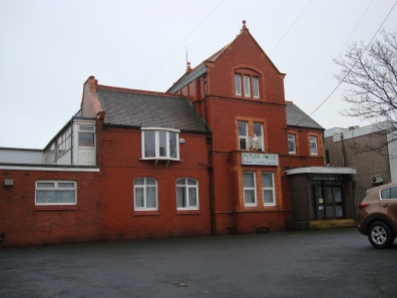
Polish Air Force Emblem WW2 (Wikipedia)
Prompted by watching the film ‘Hurricane’ recently and being aware of the role of RAF Squires Gate played during the second World War, I was intrigued to discover the role of the Polish Air Force and their connection with Blackpool. 303 Squadron, featured in the film, was formed at Squires Gate in July 1940.
Polish airmen that had fought bravely for their own country, had managed to flee to France when Poland fell to the Nazi onslaught of 1939; only to flee again at the Fall of France in 1940. Upwards of 200,000 Poles arrived in England and immediately enlisted in the RAF and other allied armed services, intent on continuing the fight against the Germans. Many having lost their families to Nazi oppression and torture. Their fight was personal.
Early in the war, around 2000 Polish Officers and men were evacuated from their HQ in Eastchurch, Kent, to mitigate the risk from invasion. Their destination Blackpool.
Blackpool, home to Squires Gate Aerodrome, served as the Depot and home of the free Polish Air Force from 1940, and included Polish Air Force HQ, 3 (Polish) Wing, No 3 School of Tech Training. Later, the Polish contingent had its Headquarters at the Goodwood Hotel, on the corner of Hornby Road and Park Road. By the end of the War, just under 20,000 polish nationals had gone through the facilities at Blackpool.
Initially, the RAF were reluctant to both recognise the fighting ability of these ‘Foreign‘ fighters and to allocate them to existing squadrons. Language and ‘cultural’ differences serving as excuses for putting these experienced pilots through basic training and English language courses. On ‘satisfactory completion’ of initial training and induction, they were allocated to newly formed Polish Air Force fighter and bomber Squadrons under RAF control. Testament to the number of Polish Pilots, 15 squadrons were formed from their number.
During World War 2, Blackpool, Weeton & Kirkham provided to largest RAF Training area. RAF ‘Squires Gate’ came into being on December 1st 1939. Among many other activities: – Elementary Flying School; Navigation School; Anti-Aircraft Operations; Reconnaissance School; Photographic School; Wireless and Telegraphy School; School of Air Sea rescue; Blind Approach Training; Transatlantic Flights; Ground Ops Training; Aircraft manufacture and many other undertakings, it was to be home for Polish Air Force (PAF) training and a Squadron base. Walton (1998) records over 750,000 RAF Personnel passed through Blackpool during the war, with 45,000 resident at any one time.
RAF Squires gate also served as the training and dispersal depot for Polish pilots and Ground Crew to the Fighter, Bomber, Coastal, Special Ops and support Squadrons in locations all over England. Several Polish Air Force Squadrons were formed up in Blackpool too. 303, 306, 307, 308, 317,
303 Squadron formed in Blackpool fought in the Battle of Britain, it was based at RAF Northolt in East London at the time and equipped with Hawker Hurricanes. 303 Squadron was responsible for almost 20% of the German aircraft destroyed during the Battle. A dramatization of the exploits of 303 Sqn has been cast in the film ‘Hurricane’ (Netflix, 2018).
Until June 1942, 307 (Polish) Squadron, equipped with Boulton-Paul Defiants, were located at Division Farm, off Leach Lane and on the Airfield perimeter, St Annes. They were charged with night defence of Liverpool and Manchester.

Memorial to Sgt Pudrycki
One Polish flyer has a direct connection with the Fylde Coast. Sgt Ottan Pudrycki, a Spitfire Pilot of 306 Sqn was killed when his Spitfire crashed in the grounds of King Edward School on Dec 5th 1941 during a training exercise in poor weather. He was reported to have made every effort to avoid hitting the School. A plaque to his memory was unveiled at the school in 1991.
Other legacies remain in the town:
‘The Polish Club’ on Hornby Road, Blackpool served as the Polish Officers Club and was referred to as the Polish Club until its change of use to offices.
The upstairs room, the original Club Bar holds memorials and artefacts from its time as the officers Club.
Polish Air Force Memorial at Sacred Heart RC Church, Blackpool

Polish Air Force Graves and Memorial in Layton Cemetery.
Despite the extraordinary contribution to Britain’s war effort, the Polish contingent was not included in the Nation’s Victory Parade in London. Under pressure from Stalin, the Polish armed services were declined an invitation. Under pressure from the RAF, 25 Polish servicemen did finally get an invite.
Recognising that the Polish ex-service personnel and civilian refugees would not be able to return home after the war, the Government introduced the ‘Polish Resettlement Corps (PRC)’ in May 1946, to assist in resettlement and integration. At the time however, it was reported that 56% of the population in the UK expressed the opinion that Poles should be repatriated (Daily Mail, 29/10/2016). Immediately post war, the Soviets took possession of Poland and many Polish servicemen and women stayed in the UK in fear of reprisals back home, many had also lost their families to the war.
A further 2018 BAFTA nominated film ‘The Last Witness’, details the ‘Katyn Forest Massacre’, when the Soviets murdered 22,000 Polish Officers and ‘Intelligencia’ in 1940. The early part of the film deals with the Polish ‘Resettlement’ arrangements and the post-war animosity towards Poles in the UK.
Blackpool retains its proud association with Poland, even 80 years after the War.
MPC
July 2020
Sources & Further Research
No participation in the Victory Parade
http://Polishsquadronsremembered.com/mailonline.html
and
https://www.britishpoles.uk/polish-armed-forces-not-invited-to-the-victory-parade-in-1946/
Polish Squadrons history
http://polishsquadronsremembered.com/
Polish Squadrons in RAF at:
https://www.rafmuseum.org.uk/research/online-exhibitions/the-polish-air-force-in-world-war-2/polish-squadrons.aspx
Buildings and activity history of Squires Gate at:
https://sites.google.com/site/blackpoolairportsquiresgate/home/1940
Wikipedia Search: ‘303 sqn’; ‘302 sqn’; ‘Battle of Britain’
References to Polish Squadron at: Hangar 42, Spitfire Visitor Centre, Blackpool Airport
Images
Copyright MP Coyle
Others referenced









Mike, I think there is some confusion in this piece regarding RAF Squires Gate as distinct from RAF Blackpool which were entirely different entities. The Poles were attached to the Polish Depot based initially at the Goodwood Hotel, Park Road, and part of RAF Blackpool. Several Polish AF flying units had their origins here but the only PAF unit at Squires Gate was 307 Squadron which spent a few months here and suffered several casualties in accidents.
LikeLike
Thanks Peter. Its a useful contribution. I can only refer you to the ‘Sources’ to the piece. If you have an addition to them I’d be delighted to include it. Thanks again.
LikeLike
Hi Mike, I’ve been doing more digging into the Polish squadrons. This is what I’ve found and verified:
307 Squadron were the only Polish squadron to operate out of Squires Gate.
Other Polish squadrons were formed at Blackpool, but operated from elsewhere. They were:
• 303 “Tadeusz Kościuszko Warsaw” Fighter Squadron. This was formed at Blackpool in July 1940, before being deployed, with their Hurricanes, to RAF Northolt on the 2nd of August that year.
• 306 (City of Torun) Squadron. In August 1940, Flight Lieutenant Tadeusz Rolski was sent to the Polish Depot in Blackpool to form this unit. “Its personnel consisted mostly of pilots from pre-war PAF units III/4 of Torun and III/3 of Poznan. Rolski was the last commander of the former, and was an obvious choice for the CO of the new squadron. However, on the 28th of August, RAF HQ issue an order to officially form the unit at Church Fenton near Tadcaster”. Sadly, one member of the 306 Squadron did return to Blackpool, when on the 5th of December 1941, Sergeant Otton Pudrycki crashed near Squires Gate and was killed.
• The 308 (City of Krakow) Squadron was formed at the RAF Polish Depot in Blackpool on the 5th of September 1940, from pilots of the Fighter Squadron of the 2nd Aviation Regiment. However, it moved to Speke for training on the 12th of September.
Polish squadron 317 had no connection with Squires Gate, except that many of its members were picked from the thousands waiting at Blackpool to be called up.
LikeLike
Thanks Nick. Always appreciated. All I can do is refer to the sources I used for the piece. By the way, Pudrycki crashed on the playing fields at King Edward School, at Fairhaven. The School has a memorial to him.
LikeLiked by 1 person
Mike/Nick,
Thanks for including me in the emails regarding Polish AF squadrons at Blackpool. It should be made clear that RAF Squires Gate and RAF Blackpool were two entirely separate entities. Squires Gate’s principal role (3 SGR) was to train aircrew for Coastal Command, it was not involved in the training and/or deployment of Polish or other aircrew en masse, except those designated as suitable for Coastal Command. RAF Blackpool, on the other hand, was a general basic training facility and included the Polish Depot under its command. Only a few units had links with both Squires Gate and Blackpool, one example being the School of Air Sea Rescue who came under the command of Blackpool whilst having an air element based at Squires Gate.
It is correct to say that 307 Squadron was the only Polish unit to be based at Squires Gate. The other Polish units mentioned were administratively formed at RAF Blackpool, before being allocated crews and aircraft elsewhere.
Nick’s History of Blackpool, lists a string of RAF units supposedly residing at Squires Gate. Many of these were based elsewhere in the Fylde and some I have no knowledge of a connection with this area.
Regards
Peter
LikeLiked by 2 people
Thanks again Peter, appreciated. All grist to the mill. It would be useful to have your sources/references, for further research.
LikeLike
Mike, the information I have has been gathered over 40 years researching a so far unpublished piece Fylde Air War Diaries. My co-researcher, Russell Brown, is concentrating on Squires Gate. The source of the information is verified by records at the PRO (now National Archives) who hold the surviving Operations Record Books (540s) for RAF squadrons, bases and misc units. Only the ORBs for squadrons are digitised. Fortunately, many years ago, I managed to get to the PRO and copy down some material on the Fylde bases.
You may be interested to know that Blackpool Council were to construct a monument at SG recording the names of the RAF personnel who died whilst based there. John Coombs of Hangar 42 asked Russell and myself to assemble a list which, from memory, came out as 70 names – if it had included Blackpool, RAF Cleveleys and RAF Fleetwood then it would likely be over 200! The council project suddenly went quiet and I haven’t had the energy to pursue the matter.
Peter
LikeLike
Hi Peter, I’ll double check my info in that case. Cheers
LikeLike